Tips for spotting fake sourdough bread at the store so you don’t waste your money on a phony product that is an unhealthy choice.
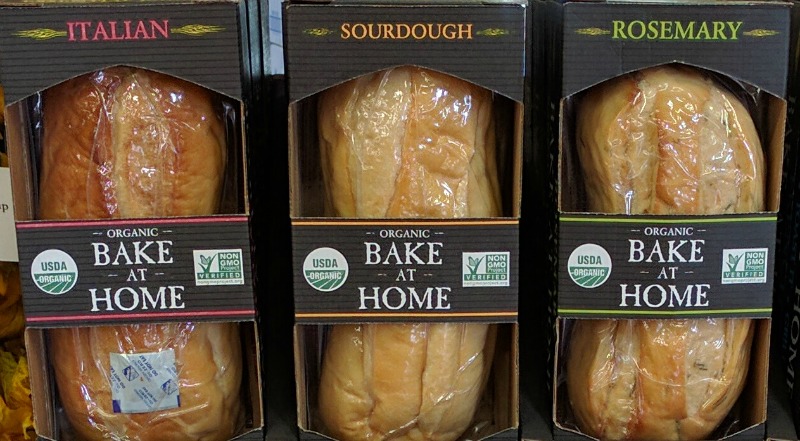
As awareness of the benefits of sourdough bread increases, so does the potential for food manufacturers – both large and small – to exploit the term.
And exploit it they most certainly do!
I recently examined every single loaf of bread at a local health food store. I found only one out of over half a dozen that claimed to be “sourdough” that was leavened in a traditional manner. No, it wasn’t The Essential Baking Company sourdough bread in the picture above. You won’t believe what this company is doing to fool consumers. Even I was shocked, and I thought I had seen it all.
If you choose to buy instead of making sourdough bread yourself (yes, it is a bit time-consuming!), then be on the lookout for fake sourdough!
It is literally everywhere!
Spotting phony sourdough is a more difficult process than you might think due in part to the sourdough myths that seem to abound.
When I first set out to write this article, I thought it would be fairly straightforward to explain. As it turns out, spotting a fake sourdough is rather tricky due to unethical food manufacturer tactics that are far sneakier and devious than I ever imagined.
You really need to be on your toes when sourcing sourdough bread to ensure that you aren’t wasting your money on a product you thought was a healthy choice for your family, but in fact, was quite the opposite.
If you use reading glasses, be sure to always bring a pair with you into the store so you can read the fine print on the packaging. If you wait until you get home to take a look, chances are you are going to be disappointed.
Fake Sourdough Masquerading as Real
The picture above shows one of the most popular fake sourdoughs on the market as of this writing. I was asked to take a look at it by a reader who thought it was legit. This brand is available at many health food stores. At my local Whole Foods, it is very prominently placed with an attractive display right near the checkout lines.
Some folks have notified me that it is also available at Sam’s Club and Walmart mega-supermarkets too!
Notice how the company has taken great care to appeal in every way to the health-conscious, time-challenged consumers:
- The loaf is clearly labeled “Sourdough”.
- The USDA Organic certification is front and center on the box.
- The NonGMO Verified label is prominently shown.
- The term “Bake at Home” is used to catch the eye of time-strapped consumers, some of whom WANT to provide fresh-baked sourdough for their family, but just don’t have the time.
I give this label a 10 out of 10. Fantastic marketing that is sure to move those boxes off the shelf like hotcakes. It’s even priced like a real sourdough would be at $6+/loaf where I live.
Watch Out for Ingredients Listed on the Box vs Online
Here’s the sneaky part. The ingredients on the label of this phony sourdough are DIFFERENT than what is on the website. Yes, the company has obviously done its research. Consumers are increasingly checking out products online before buying.
Don’t fall for this trick. Below is an online screengrab from December 28, 2016, of the ingredients for this company’s “sourdough” bread:
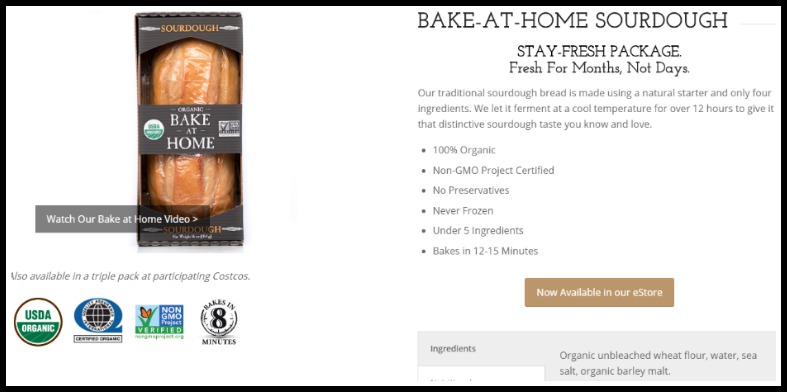
Notice the ingredients say: organic unbleached wheat flour, water, sea salt, organic barley malt.
To semi-researched consumers who know enough about sourdough bread to understand that it never contains yeast, this is enough information to fool them and get them to buy.
Take care not to be easily fooled, however! Look what I found when I looked at the actual label of this very same sourdough bread at the store. Check out the photo below taken on the very same date – December 28, 2016.
The exact same sourdough bread has YEAST listed on the box!
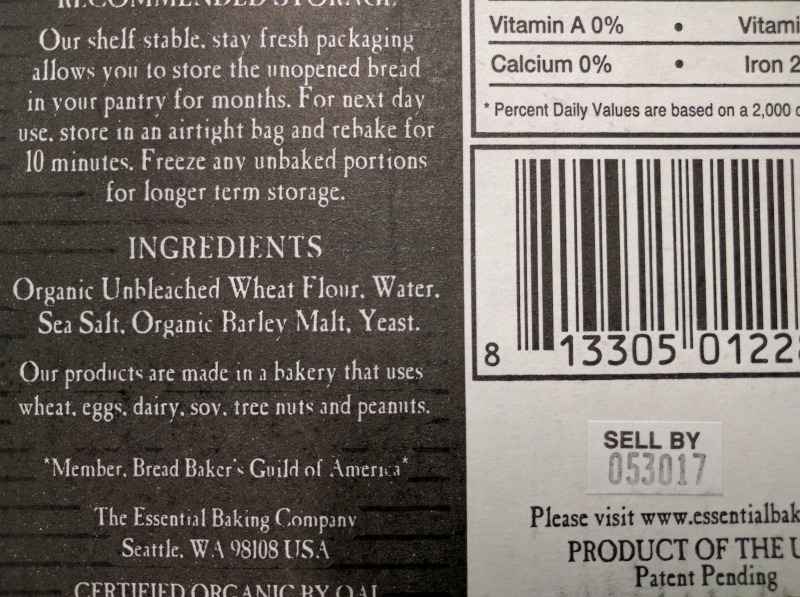
This is a new tactic I have not been aware of before … listing different ingredients for a product online versus what is on the label. Online it states “under five ingredients” using a “natural starter” with the bread “fermented” at a cool temperature for over 12 hours. The box at the store, however, lists 5 ingredients and the “natural starter” turns out to be yeast, which is most decidedly unnatural when it comes to sourdough! Other problems with this bread include the use of sweetener (organic barley malt) and white flour.
If a product seems too good to be true, it probably is.
I mean, seriously? Would an authentic sourdough come in a convenient “bake at home in 12-15 minutes” package that is shelf-stable for nearly 6 months?
Absolutely not!
The short video below summarizes the issues and how to spot the good stuff.
Authentic Labels
The label of true sourdough bread is going to list sourdough starter instead of yeast in the list of ingredients. For example, the gluten-free sourdough bread I buy from a local bakery has “cultured brown rice flour” listed as the starter.
The wording for the sourdough starter varies from brand to brand.
However, there will usually be some indication of a cultured starter as the leavening agent.
This starter contains natural beneficial yeasts from the environment rather than processed baker’s yeast which increases baking speed and baking temperature.
This is important because naturally leavened bread is more digestible, nutritious and less likely to trigger allergy problems than modern, yeast rise bread.
Ultimately, the consumer really must take the time to ensure that the sourdough bread of their choosing really is what it claims.
The Sourdough Bread I Buy
Real sourdough bread is so difficult to find that I’ve resorted to shipping freshly baked sourdough direct from the bakery to my door.
The bakery I use is Organic Bread of Heaven and I order the Rustic Sourdough. I ship in six loaves at a time and freeze what I won’t use in 4-5 days. They also have sourdough bagels, tortillas, hamburger buns, and English muffins among other authentic items.
Free shipping is available for orders over $49 (ask a friend to jump in with you!). The price is several dollars cheaper per loaf than the bread at the health food store.
To give it a try, use coupon HEALTHYHOME (all caps) for 10% off your first order.
Even if you pay shipping by ordering just a few real sourdough loaves, the price per loaf is still comparable to the fake sourdough at the health food store!
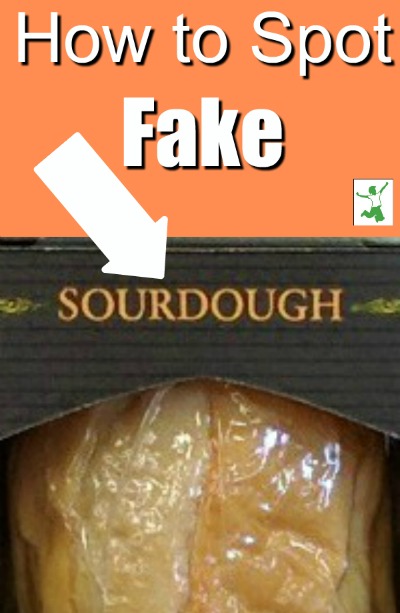
Rules of Thumb
Here are some rules of thumb to identify authentic sourdough bread:
- A handful of ingredients
- No yeast
- Cultured flour starter
- No sweetener
- Made using whole grain flour
- The dough ferments before baking for at least 4-6 hours
After examining the label, if you are still unsure, make a phone call or email to the company. Ask how long the sourdough is allowed to rise (double in size) before baking.
A true sourdough is going to rise for a minimum of about 4-6 hours and even as long as 10-15 hours depending on the temperature.
No baker’s yeast is needed. In addition, no sweetener should appear on the label.
Fake Sourdough At Panera
Be aware that Panera markets its sourdough as real when it is fake too.
Longtime reader Beth S. sent me this email from Panera customer support when she inquired about the authenticity of its sourdough bread. Beth gave her permission to reprint this email.
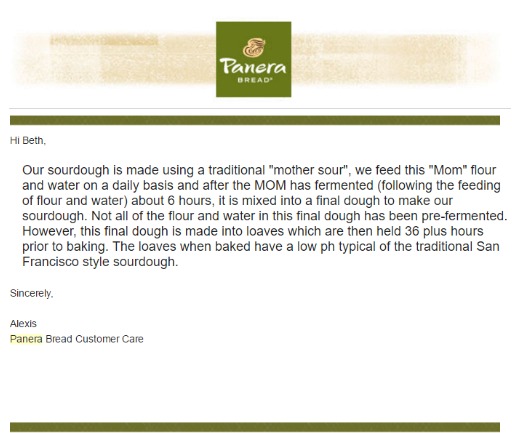
While this answer sounds promising, examining the ingredients of Panera Bread’s sourdough quickly identifies it as a fake. From the Panera website:
Unbleached Enriched Wheat Flour (Flour, Malted Barley Flour, Niacin, Reduced Iron, Thiamine Mononitrate, Riboflavin, [synthetic] Folic Acid), Water, Salt, Yeast (Yeast, Sorbitan Monostearate, Ascorbic Acid [GMO]), Dough Conditioner (Ascorbic Acid [GMO], Microcrystalline Cellulose [refined wood pulp], Corn Starch [GMO])
Not only is the Panera sourdough a phony, but it also contains yeast, wood pulp, and GMOs. It is also fortified with synthetic vitamins including dangerous folic acid (instead of natural folate).
At least The Essential Baking Company’s fake sourdough described earlier in this article is organic. This means no GMOs or other toxic ingredients.
As you can see, the phony sourdoughs on the market today range from simply misleading to downright dangerous. Best to avoid them all and get the real thing!
Do you currently buy an authentic sourdough? If so, what are the ingredients and what is the brand?








Hi Again, thank you for your responce. So, do you have an oppinion about which bread is easiest to digest and the most nutritious? I typically purchase sprouted breads but they contain yeast. I eat fermented veggies, purchase sprouted grains, use coconut oil and coconut flours, have purchase sorgham sprouted flour to cook with… my kitchen is like a health food store…READ ingredients in everything…. As you know, there are so many different oppinions on different diets, etc… Thank you again.
I don’t think any bread is easy to digest for someone with gut imbalance issues. Even sourdough or sprouted breads can be problematic. That said, if your gut is in good shape, then any authentic sourdough should be fine.
Hi Sarah, your article was very interesting. I have practiced holistic remedies, etc., etc., etc., for over 30 years and just recently learned about the benefit of sourdough. So, I want your oppinion. I’m sure you have heard about Dr. Gundry and his book ” THE PLANT PARADOX ” he states that the YEAST in sourdough destroys the lectins in the flour therefore making it easier to digest….??? Oppinion Please. Thank you so much! Cindy Ghiglione
Actually, it is the heat of the oven that eliminates most of the problem with lectins. However, the phytic acid remains even after baking unless you sour leaven (or soak/sprout) the flour first. There is no benefit to adding yeast at all to bread other than to make it bake faster, which is not the traditional approach.
More on lectins. https://www.thehealthyhomeeconomist.com/lectins/
Thanks for the article. Do you know which brand in Canada makes healthy sourdough or pumpernickel bread with a low glycemic index. Thx.
What shopping guide are you referring to and where can I find it?
It’s available from the Weston Price Foundation. westonaprice.org
Of the top 3 recipes for a sourdough start via a Google search, none of them use yeast, just flour and water.
Is the malt a big red flag? I just got a loaf from a local farmer’s market with the following ingredients:
Organic Wheat Flour, Sea Salt, Malt(Malted Barley Flour, Dextrose, Wheat Flour), Filtered Water
No mention of sourdough starter, but also no mention of yeast and a very simple list of ingredients. I guess I probably need to figure out how to contact the company that makes it to see how long they let it rise?
I wouldn’t buy that “sourdough” bread. It’s got sugar and the dextrose is almost certainly GMO.
Sarah, I looked up where to get the Berlin bread and it’s right by me! However, I looked at the packages and the slices are sooo thick. I need my bread sliced thin. I looked at several other products in the Weston Price guide, but thought maybe my search could go faster if I just asked you if you know of any recommended sourdough breads that come in a loaf so I can slice it myself?
I suggest contacting the sourdough bread companies in the shopping guide to see if there is one that meets your needs for that.
There is a well known bakery in the NYC area called Bread Alone Bakery. They are located in upstate New York. They make authentic sourdough breads, and they are organic and Kosher! They do not list “sourdough” as an ingredient as it is simply made up of flour, water and salt. Great Bread! My uncle couldn’t eat any wheat for many years. Finally tried Bread Alone and has no issues!
I would like to recommend a small authentic sourdough bread bakery in Wisconsin.
Please check it out and let me know what you think. onelovebread.com
Over years I’ve seen ascorbic acid in so so many food products…and riboflavin. How are they GMO’s? Aren’t they vitamins? And what would be a safe natural form then?
Ascorbic acid when manufactured as an additive for use in food production is almost always derived from a GMO source like GMO corn.